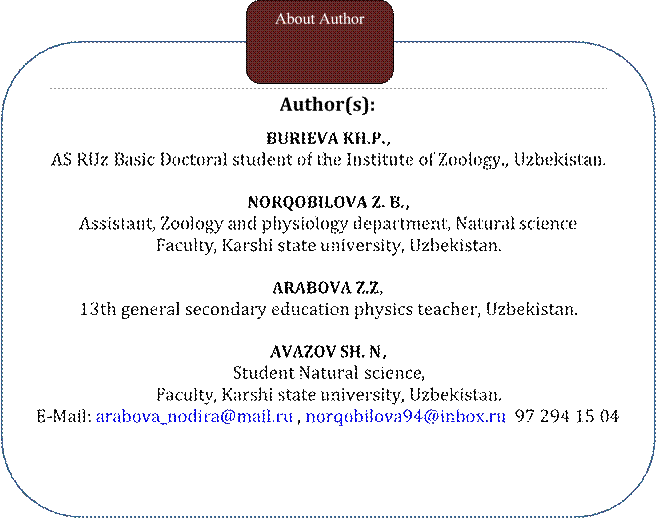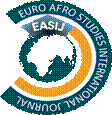
ISSN: 2707-8965 (Online) & 2708-3772 (Print)
 Volume: 3, Issue: 5 Euro
Afro Studies International Journal® 2021 (EASIJ.COM)
Volume: 3, Issue: 5 Euro
Afro Studies International Journal® 2021 (EASIJ.COM)
Page: 153 - 158
A check list of the family Coccinellidae (Latr., 1807), in Entomological collection of Institute of Zoology
Author(s), BURIEVA KH.P., NORQOBILOVA Z. B.,
ARABOVA Z.Z, AVAZOV SH. N,
Abstract:
The article provides information about the species of hard-winged insects belonging to the family Coccinellidae (Latr., 1807) in the collection of entomology of the Institute of Zoology of the Academy of Sciences of the Republic of Uzbekistan and their distribution areas.
Keywords: Coccinellinae, Scymnus rubromaculatus, Propylaea
Mulsant, Adalia decempunctata, Stethorus Weise,
EASIJ
Accepted 25 May 2021
Published 30 May 2021
DOI: 10.5281/zenodo.4892679
1 Published By


Introduction
Representatives of the family Coccinellidae (Latr., 1807) are widespread on earth. In the Palearctic region, 2,000 species of members of this family are distributed. Many species belong to the khan beetle, which lives alone in agrocenoses. Recent molecular morphological studies have also suggested that coccinellidae (Coccinellidae) be divided into 9 subspecies and 42 tribes [Nedved and Kovar, 2012; 1-12-p.].
Coccinellidae family
Coccinellinae subfamily
Coccinellini tribe
Coccinella
Coccinella Linnaeus, 1758 category Coccinella undecimpunctata (Linnaeus, 1758) type.
Area of collection and number of specimens. Kashkadarya region Abrora (44 pieces), Jizzakh (2 pieces), Kara-Kum (2 pieces), Tashkent (2 pieces), Samarkand (1 piece), Kyzylkum (1 piece), Bukhara (1 piece), Yangi Obod (2 pieces), Ertoshsoy (1 piece), Khumson (1 piece). Collection time: 23.05.1968, 02.07.1979, 22.04.1953, 15.10.1972, 15.05.1968, 07.06.1974, 1958, 04.01.1993, 10.02.1995, 06.06.1995.
Synonyms:
Distribution: It is a widespread species in Europe, Asia, North Africa, the CIS and Uzbekistan. Ecology: Although this species is widespread, it is widespread mainly in open forest areas, in the deserts and steppes as xerophiles of agricultural areas.
Coccinella septempunctata
Area of collection and number of specimens. Shakhrisabz of Kashkadarya region (2 pieces), Abrora of Kashkadarya region (2 pieces), Nishan district of Kashkadarya region (2 pieces), Tashkent region (1 piece), Jizzakh region (1 piece), Ertoshsay (1 piece), Andijan (1 piece), Surxondaryo (3 pieces).
Collection time: 13.05.1968, 20.06.1967, 09.10.1964, 09.07.1968, 02.07.1979, 07.02.1994, 27.04.1961, 17.05.1973.
Distribution: Widespread in the Palearctic and Nearctic. It is found in Asia, in all regions of the CIS, everywhere in Uzbekistan.
Coccinulla generation of time.
Coccinula sinuatomarginata Faldermann, 1837
Area of collection and number of specimens Kamashi district of Kashkadarya region (1 piece), Jizzakh (30 pieces), Khumson (2 pieces), Shafirkan district of Bukhara region (12 pieces), Yangiabad (5 pieces), Red sand (1 piece), Angren (4 pieces), Kashkadarya Karshi region (1 piece).
Collection time:
Synonyms:
Coccinula quatuordecimpustulata (Linnaeus, 1758)
Area of collection and number of specimens Tashkent region New Road (1 piece), Ertoshsay (2 pieces), Karabakh (1 piece), Jigaristan (2 pieces).
Distribution: This species is common in the Palearctic. Occurs in Europe, Asia, North Africa, CIS, deserts of Uzbekistan, forest edges, gardens, sparse forests and foothills.
Coccinula redimita(Linnaeus, 1758) type.
Area of collection and number of specimens. Ertoshsay (1 piece), Tashkent (2 pieces), Jizzakh region Bakhmal (3 pieces), Kashkadarya region Karshi (1 piece). Collection time:20.06.1996, 04.06.1978, 13.07.1976, 27.05.1968. Distribution:
Propylaea Mulsant, 1846 category.
Propylaea quatuordecimpunctata (Linnaeus, 1758) type.
The collection has been paid for and the number of samples. Tashkent region, Yertoshsay, Jigaristan. 1953, 1952, 1996, 1995, 1994.
Distribution:
The most common type of transparent art is found in Europe, Asia, Africa, CIS and Uzbekistan. Ecology: It is a mesophilic species, found mainly in trees in spring and early summer, and then migrates to melons and field crops and feeds on plant lice.
AdaliaMulsant,1846 category.
Adalia decempunctata (Linnaeus, 1758) type.
Area of collection and number of specimens. Khumson, Tashkent, Institute of Botany, Karabakh, Yertoshsay, Angren, Kamashi, 1995, 1975, 1972, 1980, 1968, 1969, 1993, 1970,
Distribution: It is a common species in the Palearctic. Widespread in Western Europe, North Africa, Japan, CIS-Europe, Siberia, Central Asian republics and Kazakhstan. Rare in desert and semi-desert areas.
Ecology: Occurs in a variety of herbaceous plants and fruit trees. The beetles overwinter under the apricot peel.
Stethorus Weise, 1885 category.
Stethorus punctillum (Weise, 1891) type.
Area of collection and number of specimens. Tashkent, Arnasay, Khumson, Karabakh, 1928, 1929, 1925, 1966, 1979, 1997, 1996
Distribution: A common species in the Palearctic. Occurs everywhere in Western Europe, North America, the CIS-Europe, the Caucasus, Siberia, Ukraine, Central Asia, Uzbekistan. Ecology It is found in fruit trees, crop fields, and wild plants around them, and beetles and juveniles feed on the eggs, larvae, and larvae of spiders.
Nephus quadrimaculatus (Herbst, 1783) type .
Area of collection and number of specimens Jizzakh, Yangi-obod, Angren, Chetsuv, Ertoshsoy, 1984, 1995, 1993.
Distribution: Occurs in the southern part of the Palearctic. It is more common in Western Europe, Siberia, the Caucasus, Central Asia, the European part of the CIS, Tashkent and Syrdarya and Surkhandarya regions of Uzbekistan.
Ecology: In the foothills, steppes and irrigated lands, cotton, hemp and cannabis are found in arable lands and feed on plant lice.
Fabr, 1787. Mantissa Lnsect.60 (Coccinella)
Type: quadrivulneratus Mulsant, 1850
Scymnus frontalis (Fabricius, 1787) type.
Area of collection and number of specimens. Tashkent, Kashkadarya, New Road, Karshi,
Andijan, Fergana, Khumson, Zaamin, Kyzyl-Kum, Bukhara, Surkhandarya, Bakhmal, SariChelak, Ertoshsay, Naugarzon, Karabakh, Chetsuv, 1929,1968,1953,1965, 1970,1962, 1969, 1952, 1961, 1951, 1970, 1974, 1975, 1973, 1979, 1997.
Distribution: Palearctic tour. It met in Western Europe, Siberia, Mongolia, former Asia, the European part of the CIS-Carpathians, the Caucasus, Irkutsk, Yakutia, Kazakhstan, Central Asia, Kyrgyzstan, Uzbekistan.
Ecology: Widespread in foothills. Perennials, acacias, and fruit trees feed on plant lice.
Scymnus rubromaculatus (Goeze, 1777) type.
Area of collection and number of specimens. Kashkadarya, Khumson, Bakhmal, Bukhara, Zaamin, Turkestan, 1968, 1969, 1974, 1976, 1975, 1967, 1976.
Distribution: Southwest Palearctic Tour. Occurs in Western Europe, Siberia, Mongolia, Central Asia, the European part of the CIS, Ukraine, Uzbekistan, Bukhara, Kashkadarya, Surkhandarya.
Ecology: Mesophilic species, common on river banks, in the lower part of the mountain range. Beetles and larvae feed on mites, nettles, reeds, sorghum, alfalfa, and alfalfa and vegetable lice. Occasionally there is a protein-rich diet in vegetables.
References
В. Ф. Хабибуллин ва О. С. Муравицкийларнинг “Атлас определитель кокцинеллид (божых коровок) (Coleoptera: Coccinellidae) и жуков-листоедов (Coleoptera:
Chrysomelidae) Башкортостана” 2011 6-25.
Собирова Д.У.,Сабчак М.Н. Инсектоакарицидная характеристика некоторых препаратов для вредных и полезных членистоногих хлопкового агробиоценоза // Вредители хлопчатника и их энтомофаги в Узбекистане. -Ташкент. – 1986. - С. 146-151. Other Sources: Websites https://www.gbif.org/ https://www.wikipedia.org/
Cite this article:
Author(s), BURIEVA KH.P., NORQOBILOVA Z. B., ARABOVA Z.Z, AVAZOV SH. N, (2021).
“ A check list of the family Coccinellidae (Latr., 1807), in Entomological collection of Institute of Zoology”, Name of the Journal: Euro Afro Studies International Journal, (EASIJ.COM), P,
153 –158. DOI: www.doi.org/10.5281/zenodo.4892679 , Issue: 5, Vol.: 3, Article: 16, Month:
May, Year: 2021. Retrieved from https://www.easij.com/all-issues/

AND
ThoughtWares Consulting & Multi Services International (TWCMSI)
Материалы на данной страницы взяты из открытых источников либо размещены пользователем в соответствии с договором-офертой сайта. Вы можете сообщить о нарушении.